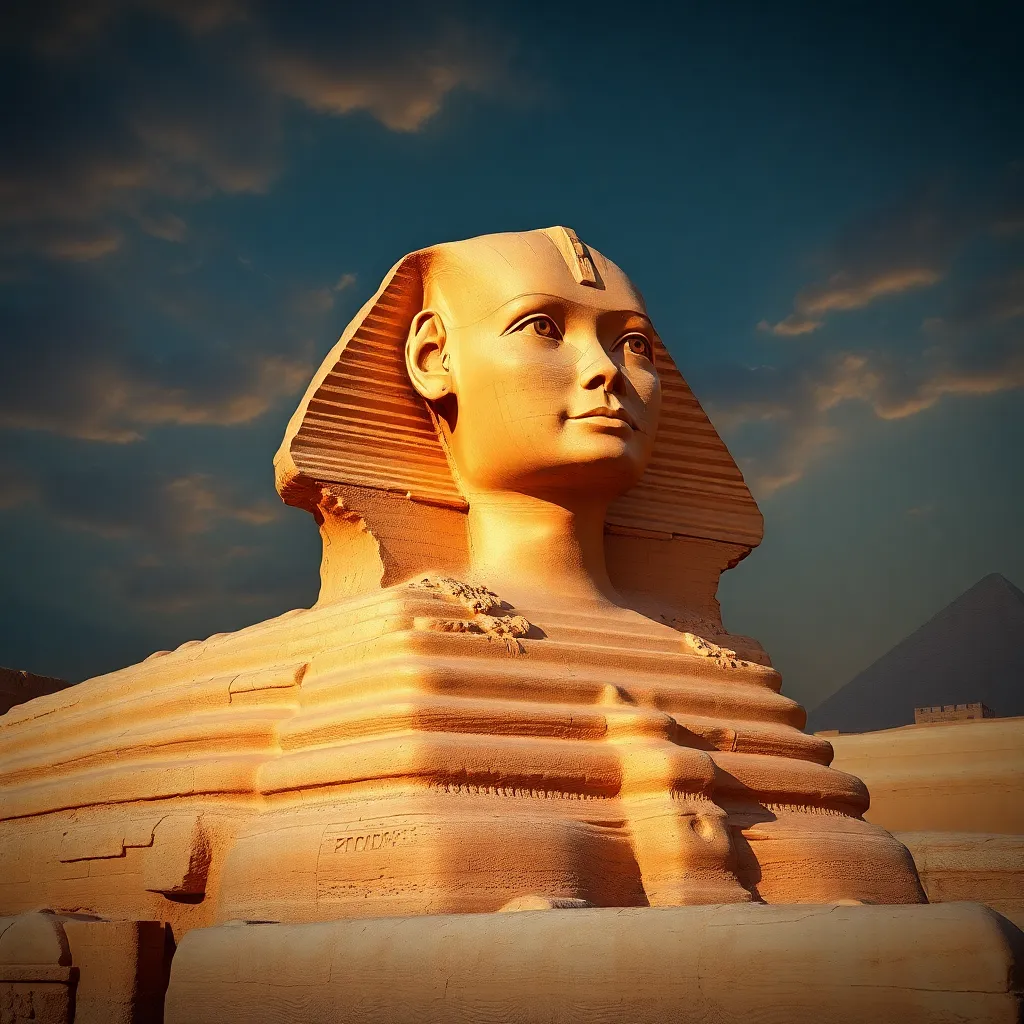The Sphinx and the Mysteries of the Ancient World
I. Introduction
The Great Sphinx of Giza is one of the most iconic monuments of ancient Egypt, shrouded in mystery and intrigue. This colossal limestone statue, with the body of a lion and the head of a human, has captivated the imaginations of historians, archaeologists, and tourists for centuries. Its significance in ancient Egyptian culture is profound, representing not only the grandeur of the civilization but also its religious and philosophical beliefs.
This article aims to explore the mysteries surrounding the Sphinx, delving into its historical context, architectural marvel, various theories, and its impact on popular culture.
II. Historical Context of the Sphinx
A. Origins and construction timeline
The Sphinx is believed to have been constructed during the reign of Pharaoh Khafre around 2500 BCE, although some theories suggest it could be even older. The exact date of its construction remains a topic of debate among scholars.
B. The role of the Sphinx in ancient Egyptian mythology
In ancient Egyptian mythology, the Sphinx was often associated with the sun god Ra and the pharaohs, symbolizing strength and wisdom. It was thought to be a guardian of the Giza Plateau, protecting the tombs of the pharaohs.
C. The Sphinx in relation to the Pyramids of Giza
The Sphinx is strategically located near the Great Pyramids of Giza, specifically the Pyramid of Khafre. It is believed that the Sphinx was constructed as part of a larger funerary complex, serving as a sentinel to the pharaoh’s resting place.
III. Architectural Marvel: Design and Structure
A. Description of the Sphinx’s physical characteristics
The Great Sphinx stands approximately 20 meters (66 feet) high and 73 meters (240 feet) long, making it one of the largest statues in the world. Its head is believed to represent Pharaoh Khafre, while its body symbolizes strength and power.
B. Techniques and materials used in construction
The Sphinx was carved from a single ridge of limestone, showcasing the advanced engineering skills of the ancient Egyptians. Workers used copper chisels and stone tools to shape the monument, and the precise alignment with the cardinal points indicates a sophisticated understanding of geometry and astronomy.
C. Comparisons with other ancient monuments
When compared to other ancient structures, such as the Colossus of Rhodes or the Statue of Zeus at Olympia, the Sphinx stands out due to its integration with the landscape and its symbolic representation of ancient Egyptian beliefs.
IV. Theories and Speculations
A. Various interpretations of the Sphinx’s purpose
Throughout history, the purpose of the Sphinx has been interpreted in various ways, including:
- A guardian of the tombs and the afterlife
- A symbol of pharaonic power and authority
- An astronomical observatory aligned with celestial events
B. Theories regarding its alignment with celestial bodies
Some researchers suggest that the Sphinx is aligned with the constellation Leo, which rises in the east at the time of the summer solstice. This has led to speculations about the Sphinx’s role in ancient astronomical practices.
C. Speculations about hidden chambers or passages
Various theories suggest that there may be hidden chambers or passages beneath the Sphinx. Ground-penetrating radar and other technologies have been used to explore these possibilities, yet no definitive evidence has been found.
V. The Sphinx in Popular Culture
A. Representation in literature and art
The Sphinx has inspired countless works of literature and art throughout history. It appears in ancient texts, such as Oedipus Rex, where it poses a riddle to travelers, symbolizing the mysteries of life and death.
B. The Sphinx in movies and television
In modern media, the Sphinx has appeared in numerous films and television shows, often depicted as a gateway to ancient secrets or as a symbol of enigmatic power.
C. Impact on modern interpretations of ancient history
The fascination with the Sphinx has influenced contemporary views on ancient civilizations, prompting further exploration and study of Egypt’s rich history.
VI. Archaeological Discoveries and Research
A. Key archaeological findings related to the Sphinx
Over the years, numerous archaeological discoveries have been made near the Sphinx, including:
- Artifacts from the surrounding area that provide insight into the daily life of ancient Egyptians
- Prehistoric tools indicating earlier human activity
- Remnants of temples and structures that may have been associated with the Sphinx
B. Ongoing research and debates among historians and archaeologists
The study of the Sphinx continues to be a hot topic among scholars, with ongoing debates about its origins, purpose, and the methods used in its construction.
C. Technological advancements in Sphinx studies
Recent advancements in technology, including 3D scanning and remote sensing, have allowed researchers to gain new insights into the Sphinx and its surrounding structures, leading to exciting discoveries.
VII. The Sphinx as a Symbol of Mystery
A. The allure of the Sphinx in contemporary society
The Sphinx remains a symbol of mystery and intrigue in modern culture, drawing millions of visitors each year who seek to unravel its secrets.
B. The Sphinx in relation to other ancient wonders
Alongside wonders like the Great Pyramid of Giza and Stonehenge, the Sphinx exemplifies humanity’s fascination with the past and the mysteries that remain unsolved.
C. The quest for knowledge and understanding of ancient civilizations
The Sphinx represents humanity’s enduring quest for knowledge about ancient civilizations, inspiring researchers and enthusiasts alike to continue exploring the depths of history.
VIII. Conclusion
The Great Sphinx of Giza holds immense significance in the ancient world, symbolizing the power and mystery of the pharaohs. Despite centuries of research and exploration, many mysteries surrounding the Sphinx remain unresolved. Its allure continues to inspire both scholarly inquiry and public fascination, encouraging future generations to delve deeper into the wonders of ancient history.
As we seek to understand our past, the Sphinx stands as a testament to the ingenuity and spirituality of a civilization that, even in its mysteries, continues to captivate the world.




